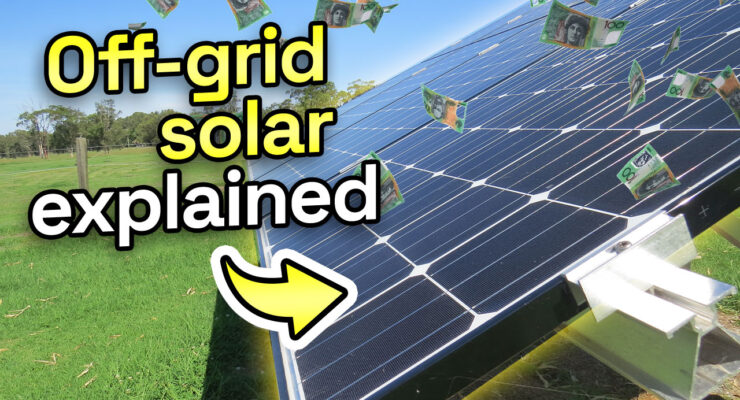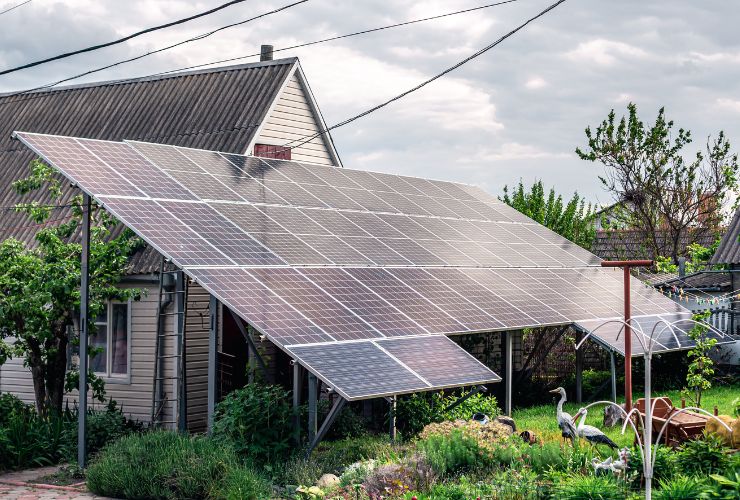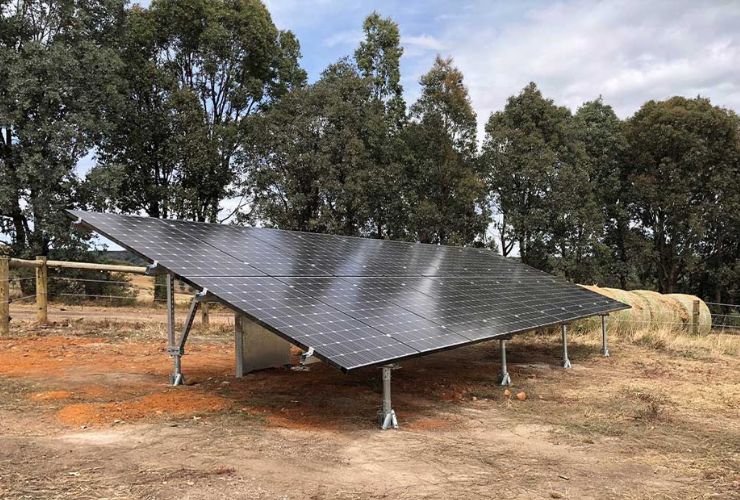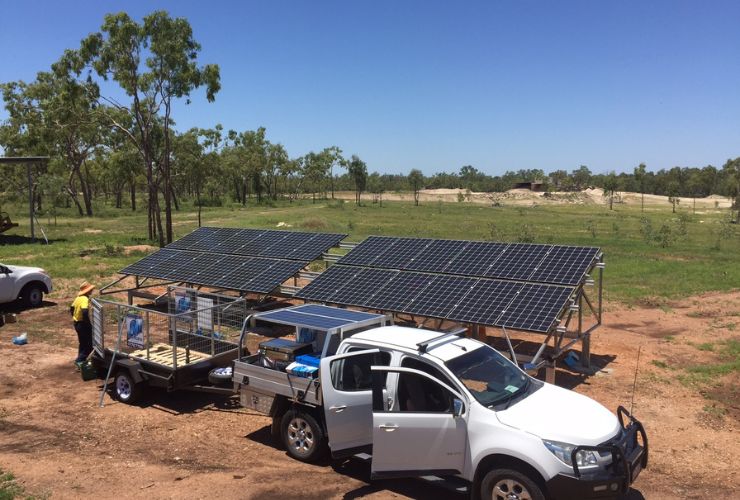
Fast read
If you are interested in sustainable, independent living through off-grid solar systems.
It discusses motivations like cost savings, environmental concerns, and self-sufficiency. Key topics include assessing energy needs, system sizing, and choosing reliable components like lithium batteries and high-quality solar panels.
The guide explains the benefits of living off-grid. These benefits include saving money, being self-sufficient in energy, and being prepared for higher electricity costs. It also covers practical steps from initial load assessment to installation and maintenance, emphasising the importance of quality equipment for optimal performance and longevity.
What is off-grid solar and how does it work?
Embarking on the journey to adopt an off-grid solar system for your home requires careful consideration and understanding.
This guide explains important considerations when choosing an off-grid system. It also showcases the various options available. Additionally, it highlights the importance of having a reliable off-grid inverter and batteries for a successful system.
We will examine various batteries to determine the most suitable ones for different needs. This will enable people to enjoy a comfortable and sustainable off-grid lifestyle.
Why choose off-grid solar
Living off the grid is very popular in Australia as people want more freedom from fossil fuel power sources. Sometimes there is also no choice as the cost of running powerlines to a remote property can be prohibitive.
Financial freedom
People go off-grid to be financially free and independent from energy providers by getting rid of electricity bills. Generate power at home, not from the grid, to avoid fluctuating power bills and have financial certainty.
Environmental sustainability
Adopting an off-grid solar PV system contributes to a reduced carbon footprint. Solar power is a clean and renewable energy source. It helps people live sustainably and fight climate change. This is achieved by using less fossil fuels and reducing environmental harm.
Protection against electricity price increases – Traditional grid-tied systems are susceptible to large electricity price increases. As we all know electricity costs have increased above the rate of inflation for some years. Going off-grid shields homeowners from grid power price increases and creates certainty.
Personal choice and philosophy – Beyond practical considerations, off-grid living often aligns with personal philosophies and lifestyle choices. Some people disconnect from centralized power systems to be self-sufficient and live in harmony with nature.
How does off-grid solar works?
It is simple, reliable, and affordable compared to wind and hydropower options. Solar energy is appealing because it doesn’t have moving parts, has been tested for years, and needs little maintenance. Also, panels, inverter solutions and even batteries have reduced in price over the past decade.
Good batteries are important for a steady power supply, especially when it’s rainy, cloudy, or nighttime. Good battery types are lithium and lead-acid (flooded, gel, and AGM). Lithium is becoming more popular for off-grid setups because it is efficient and reliable. For an in-depth exploration of battery chemistry contact us for further information.

Types of off-grid systems
Off-grid systems are categorised as either AC or DC-coupled, based on the scale of the setup. Smaller systems typically utilise DC coupling with efficient MPPT solar charge controllers.
Bigger home systems can use either type, depending on the off-grid inverter and compatibility with solar inverters or charge controllers. The most modern inverters can accommodate both AC and DC coupling, offering a versatile and secure energy solution.
Misconceptions and realities
A common belief is that assembling an off-grid solar system is straightforward. This may hold some truth for smaller setups like caravans or cabins. Bigger energy systems for homes and businesses need a lot of money and careful planning to avoid problems. They cost tens of thousands of dollars.
Expertise in considering factors such as household energy requirements, peak demand, solar exposure, and potential system losses is paramount.
Make sure the size is right
Sizing the solar and battery systems correctly is also crucial. This is where experience and excellent off-grid design skills come into play. If you design the system too small, then you will rely on backup generators too often. If on the other hand, you design the system overly generous, then you could be wasting money.
Backup generation
While designing an off-grid system without a backup generator is technically feasible, this approach has trade-offs that may not align with your preferences for reliability and comfort. Without a backup generator, these scenarios may unfold:
For long periods of poor weather, a large solar array and battery bank are needed. This can significantly increase off-grid solar panel system costs.
Economic considerations in cloudy regions
In areas with frequent cloudy weather, an excessively large solar and battery system may not be cost-effective. Combining solar, battery, and backup generators is often a more viable solution.
Your power usage and home location are critical in designing a reliable off-grid system. Our off-grid solar designers possess specialised skills beyond those of standard grid-connected installers.
Should I get an off-grid system?
Off-grid solar power offers a reliable and efficient way to generate electricity independently. The specific benefits are:
Self-sufficiency and reduced reliance on the grid
By generating your electricity, you become less dependent on the grid, increasing self-sufficiency and avoiding traditional electricity bills.
Feasibility in remote regions
The availability of grid connections does not limit off-grid solar. It is a practical solution for homes in remote areas, where grid connections are often less reliable.
Weather resilience
Off-grid systems are designed to power homes regardless of weather, so power loss on rainy days is not a concern.
Considerations and Cost Estimates
To see if off-grid solar is right for your home, you must understand your energy needs, scale, and costs.
The investment for a residential off-grid solar system can vary widely. A basic setup for essential electrical needs might range from $15,000 to $25,000, while more comprehensive systems for small, efficient homes may cost between $25,000 and $55,000.
Energy usage and system size
Understanding your energy needs is critical. A rule of thumb suggests that a system delivering 5kWh/day with an even day/night split will start around $25,000.
Economies of scale
Larger systems benefit from economies of scale. For example, a 30kWh/day system would start at approximately $75,000. These estimates exclude a backup generator and also depend on the Peak load capacity (how much power the system can release as a peak), the remoteness of the location, the sophistication of the monitoring system and the quality of the components.
When evaluating the suitability and efficiency of an off-grid solar system for your home, pay attention to several crucial factors:
Assessing energy needs
Start by examining your energy consumption and usage habits. Look at your electricity usage, considering hot water systems, cooking appliances, temperature control, and household size. Understanding your energy needs ensures your chosen off-grid solar system meets your requirements and provides consistent, reliable power.

System size determination
After understanding your energy needs, decide the right size for your solar and battery system. Collaborate with our experienced off-grid team. They will help you design a solar power system that fits your home’s size, energy usage, and desired self-sufficiency. Our friendly staff will help calculate the solar array’s kilowatt-hours and the batteries’ required storage capacity.
Sunlight and panel placement
Assess sunlight availability, considering shading from structures or trees and your area’s climate. Our specialists will identify the best location, orientation, and tilt for solar panels to optimise efficiency. If your roof is small, consider a free-standing array, though it may increase costs.
Future-proofing
Think about your property’s long-term plans, including potential expansions. Plan for a system that can handle future energy needs to avoid future retrofitting costs. For example, oversizing the system can be beneficial if you plan to add an electric vehicle soon.
Each home is unique, so consult with our experts to assess your needs and find the best off-grid solar solution.
Getting off-grid solar – the steps
Here’s a step-by-step guide to understanding the process:
Step 1 – Load profile
In the initial phase, experienced and accredited off-grid designers collaborate with you to create a detailed load profile. This involves understanding your power needs by hour, day, and season.
The team designed the system to use solar power during the day and store energy in batteries for nighttime use. Heavy-use appliances may also be considered for generator power, especially when budget constraints come into play.
Step 2 – Site assessment
For existing sites, on-site visits are conducted to determine equipment locations, shading factors, and roof sizes. Our designer uses site plans and aerial images to gather information for new builds or remote sites.
Step 3 – Design
We use special software to design a detailed system based on your energy needs and site information.
This includes determining the optimal solar, battery, and generator capacity for your power needs and budget. Our staff walks you through any necessary compromises, providing clear advice on trade-offs between cost and functionality.
Step 4 – Build
Efficiency is prioritised by pre-building and configuring systems off-site. This reduces on-site installation time.
While there are now do-it-yourself off-grid solar system kits available, please consider that you will be with limited after-sales support if you choose this option. The initial savings will quickly vanish in the future. Experts will need to locate and fix issues with a system that may not have been flawless from the start.
Step 5 – Installation
Complete installation services are provided by us and carried out by accredited and qualified staff. Depending on the complexity of the off-grid system it will take 1-2 days for the installation and hand-over.
Step 6 – Service & Monitoring
Beyond installation, we offer additional services including monitoring and remote support capabilities. These minimise call-out and travel costs. Ongoing system servicing and maintenance are also provided to ensure continued optimal performance for many years to come.
Step 7 – What to watch out for
Careful planning required – Off-grid living demands meticulous planning, considering energy needs and consumption patterns. Picking the correct solar system size and having sufficient battery storage is crucial for success when sunlight is scarce.
Conscious energy usage – Adjusting to off-grid living involves a heightened awareness of energy usage.
While off-grid living presents its challenges, the rewards are substantial. You can control your energy future and help the environment while saving money.

Key components for off-grid solar success
Choosing the right gear for your off-grid solar system is crucial for top performance and lasting achievement. With many choices, it’s important to make informed decisions that match your needs and goals.
Solar panels
When it comes to solar panels, prioritise high-quality options from reputable manufacturers. Look for panels with high-performance ratings, low degradation rates, and extended warranty periods.
It is recommended to have a product warranty of at least 25 years for your solar panels. This will protect your investment and ensure their long-term efficiency. Consider the efficiency of N-type panels, known for their effectiveness, or opt for the more budget-friendly less efficient P-type panels, if you have the roof space.
Inverter solutions
The inverter converts the DC electricity generated by solar panels into usable AC electricity for your home. Choose a good off-grid inverter like Selectronic (made in Australia) that works well with your solar panels. We can assist you in assessing capacity, reliability, and warranty details to ensure longevity.
Solar batteries
Battery storage is important for off-grid solar systems to store extra energy when there is little sunlight or at night.
Historically, lead-acid batteries were the go-to option for off-grid systems because of their reliability and longevity. However, in recent years, lithium-ion batteries have gained popularity for their higher efficiency and lighter weight.
Enhance your off-grid solar system by selecting top-notch components for increased efficiency and longevity. Consult our specialist to find the right parts for your specific needs, ensuring optimal performance and long-lasting success.
Doing it right the first time
When considering off-grid solar systems, quality is fundamental, regardless of the specific provider. Choosing the right size and equipment is important for the performance and durability of your off-grid solar system.
Investing in good parts may cost more at first, but the long-term advantages are worth the initial expenses. Quality components contribute to:
- Optimal performance and efficiency
- Durability and longevity
- Ongoing comfort and no surprises
- Safety and reliability are non-negotiable
Off-grid solar systems involve the storage and distribution of electricity, making safety a critical consideration. You are now managing your own power station. Therefore quality components from reputable manufacturers are a must. They will lead to higher safety standards and stronger reliability.
Warranty protection and peace of mind
Opting for quality components often comes with additional warranty protection, providing peace of mind for your investment. Key points to consider when picking the components include:
- Longer warranties – Reputable manufacturers offer longer warranties, showcasing confidence in the quality and durability of their products.
- Addressing concerns about upgradability is crucial for those planning to expand or modify their off-grid solar systems over time.
- Plan for upgradability from the start. Planning for an upgradeable system from the beginning is better than trying to upgrade later.


